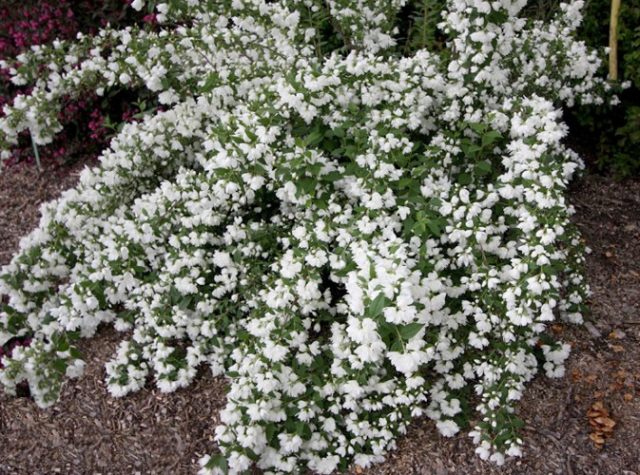Content
Chubushnik Snowbel is a shrub that is mistakenly called garden jasmine. Unpretentious, with snow-white fragrant flowers, Snowbelle mock-orange is a favorite among other varieties. Snowball - this is what gardeners call it for the abundance of buds during the period of mass flowering.
Description of the Jasmine Snowbelle variety
Chubushnik Snowbel, according to the description of gardeners, is a low bush - up to 1.5 m, which is clearly visible in the photo.
Forms a spreading crown due to arcuate lateral shoots. Its diameter is the same as its height. During flowering, Snowbelle's mock-orange represents a white bell. The leaf blade is ovoid, dark green in color. Its edge is even, sometimes with small notches. The leaves are slightly pubescent, up to 4.5 cm in size.
Chubushnik Snowbel is a self-pollinated crop, contains bisexual flowers.
How Snowbelle's Crown Chubushnik Blossoms
Jasmine Garden Snowbelle blooms profusely, as in the photo above. The flowering period is long, from mid-May to mid-June. Forms buds on last year's shoots. Flowers are large, up to 2-3 cm in diameter, double. The outer corolla is formed by oval, and the inner row is formed by oblong petals. The buds are very densely arranged in the inflorescence. They have a delicate aroma reminiscent of jasmine.
Chubushnik Snowbel blooms fascinatingly. Sometimes this period does not come. The reasons influencing the flowering of the shrub can be:
- lack or excess of moisture;
- freezing of the kidneys during the cold period;
- a planting site that does not meet the requirements of the bush.
Main characteristics
Chubushnik Snowbel belongs to the 5th zone of winter hardiness. It survives frosts well down to -28 degrees. At a lower temperature, the buds freeze slightly, but with development the shrub quickly regains its decorative qualities.
Corona jasmine is drought-resistant, it also feels good in urban conditions. Transferring all types of cropping. Grows well in various soils. Dislikes increased moisture, salinity. Chubushnik is shade-tolerant, but grows better in lighted places.
Chubushnik Snowbel is resistant to diseases and pests. Can be susceptible to disease if not properly cared for. The most dangerous pest is aphid.
Based on the description of the main characteristics, the Snowbelle mock-orange can be grown with a minimum amount of time in central Russia, in contrast to the present jasmine.
Breeding features
They use different methods of growing Snowbelle mockers. These include:
- reproduction by seeds;
- root suckers;
- cuttings;
- layering;
- dividing the bush.
The most effective methods are cuttings and layering. With this reproduction, the chubushnik retains varietal qualities.
Planting and caring for Snowbelle jasmine garden
In order for the Snowbelle jasmine to annually please with abundant flowering, it is necessary to properly organize the planting and care of the shrub. It will also save the culture from various diseases.
Recommended timing
Snowbelle is planted in spring and autumn. It is advisable to plant in the spring before bud break. In autumn, they are planted long before frost, so that the shrub has time to germinate.
Site selection and soil preparation
Chubushnik Snowbel prefers areas well lit by the sun. It tolerates partial shade and shade well, but in this case, the shoots are drawn to the sun, there is no abundant flowering.
Chubushnik Snowbel can grow in any soil. Fertile soil is preferable, which includes leafy soil, humus and sand. The components are brought closer to a ratio of 3: 2: 1.
Landing algorithm
Planting and subsequent care of the Snowbelle mock-up is simple. Follow the rules:
- Prepare a pit 50 x 60. If a group planting is carried out, leave a distance between the bushes up to 1.5 m. When decorating a hedge, place a chubushnik every 0.5-1 m.
- Drainage is laid at the bottom of the pit with a layer of up to 15 cm.
- Prepared soil is poured onto it.
- If the chubushnik sapling with an open root system, it is carefully straightened and covered with earth. If the root system is closed, transferred with a lump of earth, add soil.
- The root collar is left at ground level. It can be buried, but not more than 3 cm. Otherwise, decay may occur.
- The soil is tamped, moistened abundantly, using up to two buckets of water, mulched.
Growing rules
According to gardeners' reviews, Snowbelle's chubushnik is unpretentious. Nevertheless, some care rules must be known and followed in order to get abundant flowering.
Watering schedule
Chubushnik (Philadelphus Snowbelle) is picky about watering. In the absence of moisture, the leaves become lethargic, the shrub may not bloom. Therefore, during the growing season, it is recommended to water the plant regularly, every week. Up to 3 buckets of water are taken for an adult bush.
Weeding, loosening, mulching
During the summer, the near-trunk circle of the chubushnik is cleaned of weeds. At the same time, the soil surface is loosened to a depth of 4-8 cm. Deeper loosening is not recommended, so as not to damage the roots. During the warm period, 2-3 loosening procedures are carried out.
The cleared land under the bush is mulched. Peat, sawdust, crushed bark are used. Pour a layer of mulch up to 3-4 cm.
Feeding schedule
Gardeners pay great attention to feeding the Snowbelle mock-orange. Every year they fertilize with mullein infusion. Prepare it in a ratio of 1:10. The use of mineral fertilizers begins in the 3rd year. Top dressing is carried out according to the scheme:
- For every 1-2 bush, 10 liters of solution are prepared. Add 15 g of potassium sulfate, 15 g of urea, 15 g of superphosphate.
- After the flowering period, they are applied to the soil for every 1 m2 20-30 g of phosphorus fertilizer, 15 g of potash and 100-150 g of ash.
Pruning
Jasmine Snowbelle in the photo looks well-groomed. You need to know that it only happens as a result of regular pruning and shaping. It is divided into groups:
- Since the shoots of Snowbelle's mock-orange are distinguished by uneven growth, formative pruning is carried out to give the plant a shape. Strong shoots shorten a little. Weak branches are pruned harder so that they stimulate the growth of annual shoots. The work is done in the spring.
- At the age of 2-3 years, the rejuvenating crown is pruned. Old branches are removed, leaving those less than 10 years old. As a result, the shrub blooms profusely.
- Over time, there are so many shoots that the chubushnik bush thickens. Decorativeness falls. Perform anti-aging pruning. In spring, a small number of branches, namely 3-4, are shortened to 40 cm. All other branches are removed to the surface of the ground, it is recommended to process naked sections with garden pitch. The area around the bush is mulched with compost. Chubushnik is watered, fed with a mullein. By the autumn period, new shoots grow. In the spring, up to 3 of the strongest shoots are left on each stump, the rest are removed. This is the base of the bush.
- Sanitary pruning of the chubushnik is carried out annually. Remove broken, diseased branches. In the summer, brushes that have faded are removed.
Preparing for winter
Garden jasmine or, as many people think, Snowbelle does not require special preparation for the winter period. You can also take care of the correct location of the seat during landing.
Pests and diseases
According to gardeners, Snowbelle jasmine garden is resistant to disease. But if agrotechnical methods are violated, diseases can strike him:
- Gray rot. For prevention purposes, it is recommended to thin out the shrub, remove fallen leaves. In case of defeat, they are sprayed with preparations: "Skor", "Chistotsvet", "Keeper", "Agrolekar".
- Septoria spotting. Round brown spots up to 1 cm in diameter appear on the leaves. Later, black fruit bodies are formed. Over time, cracks appear in the center of the spots on the necrotic tissue, then they fall out. Leaves die off. The treatment with Bordeaux liquid helps.
The main pests of the chubushnik:
- Aphid. They cope with it with the help of "Fufanon", "Inta-Vira", "Fitoverma", "Iskra".
- Hawthorn butterfly. For the destruction of pupae and caterpillars use drugs "Iskra", "Fufanon".
- Click beetles. Larvae and beetles hibernate in the soil, gnaw at the roots. They spoil the leaves of the bush. The same preparations are eliminated from the pest, and liming of acidic soil, mandatory drainage, also helps.
- FROM tick and weevil cope with insecticides "Fufanon", "Phosphamide".
Conclusion
Chubushnik Snowbel is a beautiful ornamental shrub. Simple and affordable to care for. With a minimum of effort, every interested gardener can grow crown jasmine.











